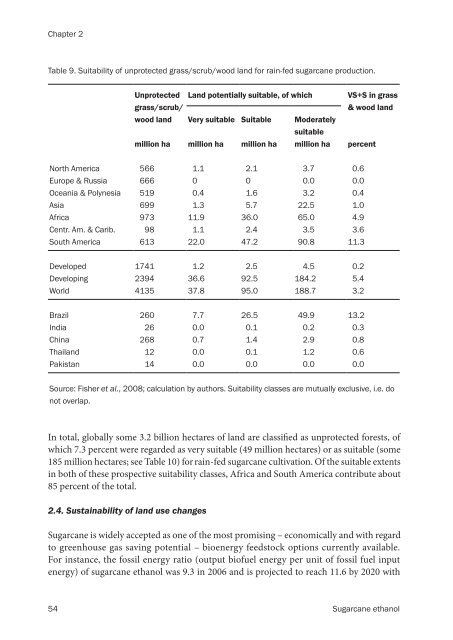Sugarcane ethanol: Contributions to climate change - BAFF
Sugarcane ethanol: Contributions to climate change - BAFF
Sugarcane ethanol: Contributions to climate change - BAFF
Create successful ePaper yourself
Turn your PDF publications into a flip-book with our unique Google optimized e-Paper software.
Chapter 2<br />
Table 9. Suitability of unprotected grass/scrub/wood land for rain-fed sugarcane production.<br />
Unprotected<br />
grass/scrub/<br />
wood land<br />
million ha<br />
In <strong>to</strong>tal, globally some 3.2 billion hectares of land are classi�ed as unprotected forests, of<br />
which 7.3 percent were regarded as very suitable (49 million hectares) or as suitable (some<br />
185 million hectares; see Table 10) for rain-fed sugarcane cultivation. Of the suitable extents<br />
in both of these prospective suitability classes, Africa and South America contribute about<br />
85 percent of the <strong>to</strong>tal.<br />
2.4. Sustainability of land use <strong>change</strong>s<br />
Land potentially suitable, of which VS+S in grass<br />
& wood land<br />
Very suitable Suitable Moderately<br />
suitable<br />
million ha million ha million ha percent<br />
North America 566 1.1 2.1 3.7 0.6<br />
Europe & Russia 666 0 0 0.0 0.0<br />
Oceania & Polynesia 519 0.4 1.6 3.2 0.4<br />
Asia 699 1.3 5.7 22.5 1.0<br />
Africa 973 11.9 36.0 65.0 4.9<br />
Centr. Am. & Carib. 98 1.1 2.4 3.5 3.6<br />
South America 613 22.0 47.2 90.8 11.3<br />
Developed 1741 1.2 2.5 4.5 0.2<br />
Developing 2394 36.6 92.5 184.2 5.4<br />
World 4135 37.8 95.0 188.7 3.2<br />
Brazil 260 7.7 26.5 49.9 13.2<br />
India 26 0.0 0.1 0.2 0.3<br />
China 268 0.7 1.4 2.9 0.8<br />
Thailand 12 0.0 0.1 1.2 0.6<br />
Pakistan 14 0.0 0.0 0.0 0.0<br />
Source: Fisher et al., 2008; calculation by authors. Suitability classes are mutually exclusive, i.e. do<br />
not overlap.<br />
<strong>Sugarcane</strong> is widely accepted as one of the most promising – economically and with regard<br />
<strong>to</strong> greenhouse gas saving potential – bioenergy feeds<strong>to</strong>ck options currently available.<br />
For instance, the fossil energy ratio (output biofuel energy per unit of fossil fuel input<br />
energy) of sugarcane <strong>ethanol</strong> was 9.3 in 2006 and is projected <strong>to</strong> reach 11.6 by 2020 with<br />
54 <strong>Sugarcane</strong> <strong>ethanol</strong>












